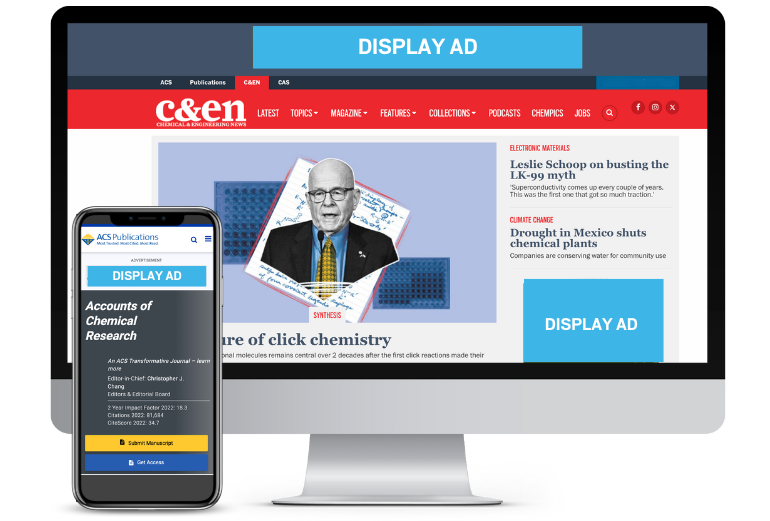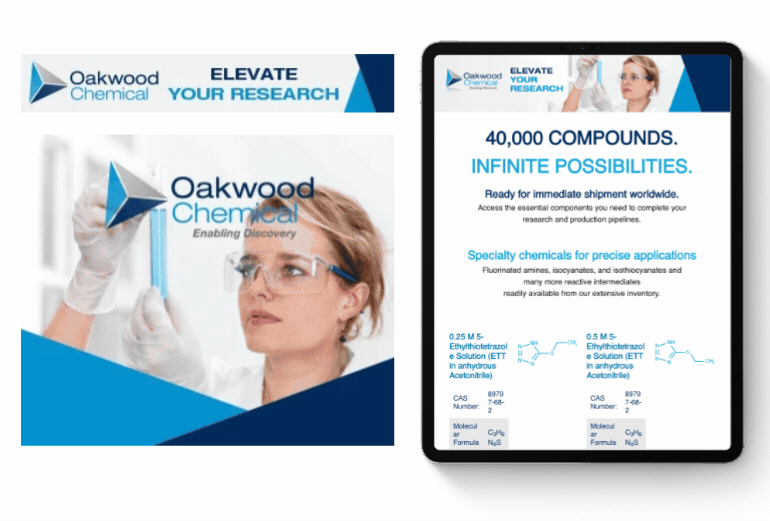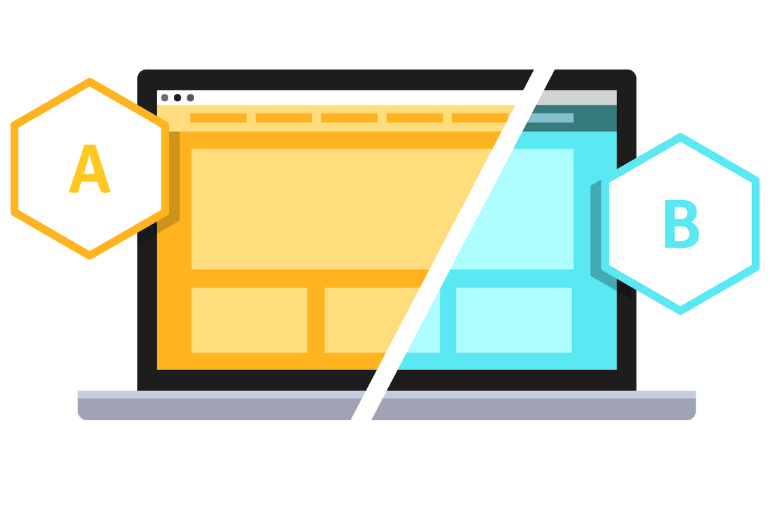Display advertising can be a powerful tool for science brands. When executed effectively, they can reach your ideal customers on the sites they frequent most and capture their attention with finely tuned messages and incentives to click through. Whether you are new to digital marketing or an experienced pro, brushing up on best practices before launching your campaign is always helpful.
What is Digital Display Advertising?

Digital display ads, also known as banner ads, are digital advertising units that allow you to visually showcase your brand and products on various online platforms. These ads have a call to action (CTA) and are hyperlinked to a landing page. Banner ads can be static images or animated GIFs and are typically found in standard sizes set by the Interactive Advertising Bureau (IAB). Popular standard digital display ad sizes include:
- 728×90: leaderboard display ad
- 300×250: medium rectangle display ad
This standardization allows brands to use the same art across multiple publishers and advertising partners, thus maximizing ROI.
Research and Prep-Work for Effective Targeting
Before creating your ads, you must identify your target audience and goals. Defining these key factors will help guide your ad’s placement, design, content, and call to action. For your ad to succeed, you must reach the right audience at the right time with the right message. Think about your target audience and ask yourself these questions before launch:

products among active members of the biotech and pharmaceutical community. By identifying seven ACS Journal websites that aligned with their campaign goals, they were able to drive more than 4.3 million impressions and 3,4000+ landing page visits.
- What outcomes do you want from your digital advertising campaign? Is it raising awareness around your brand or specific product? Is it generating leads through a value share registration like a white paper or webinar? Whatever the case, defining your outcome goals early on can help inform both your segmentation and design.
- What websites are most appropriate for your campaign? Consider the goal you just defined. Now, think about the ideal customer you’d like to reach with that goal. What websites do they visit? What are their primary sources of information?
- Do you want to reach users at a particular company? Domain targeting can help you do that. This type of segmentation is especially helpful when trying to fill the end of the sales funnel for account management or prospecting.
- What keywords do people search for when they find your company? Utilize tools like Google Search Console and Keyword Planner to determine the top queries bringing users to your site. Display ads can target segments based on visitors consuming content related to your keywords and phrases.
- What geography is most relevant to your company? If your goal is a brand lift, you may not need to hone in so specifically. However, if you’re promoting an event, that will likely inform both your ad copy and your geo-targeting.
- Do you want to exclude any users, domains, or geographic regions? If you don’t sell your product or service in a particular territory, exclude that in your campaign so you’re not wasting ad spending on irrelevant impressions.
Design and Content Tips for Impactful Science Display Ads
Once you’ve defined your goals and how you will target your audience, it’s time to design! Here are five key factors to create an effective digital display ad for your science brand:
1. Consistently Brand and Theme Your Display Ad Campaign

Building a cohesive theme for your digital campaign is critical to its success. If you’re creating multiple ad units for your campaign, you want to ensure consistency. What should be consistent exactly? From colors to fonts to a main image, creating a uniform look and feel across your digital campaign reinforces recognition and brand identity.
The overall goals for your ads should also be consistent. Don’t advertise one product on one ad and then a completely different product on another ad that’s part of the same campaign. If the overall design of the ads is similar, the goals of those ads should be as well.
2. Keep Your Design Eye-Catching But Simple
So, you have the concept and overall design theme in mind. When relaying this to your designer, a few other important factors can make or break your campaign.
You want to make your ad buy worthwhile, so you may be tempted to add a lot of information. However, consider how much content the average user consumes while browsing the web, especially on science and research publications. Your ad should be concise, to the point, and catchy. (‘Catchy’ in the chemical industry is not the same as ‘catchy’ in more traditional B2C campaigns, so being very familiar with your target audience will come into play.)
Always ask yourself: what is the hook, and what makes you different?
3. Include a Clear Call to Action
You could have the world’s most beautiful ads, but if they don’t have a proper call to action, you’re seriously hurting your chances of getting clicks. Buttons or clear text telling users what to do is vital to securing action. If you’re advertising an upcoming webinar, tell users to sign up or register. If you’re promoting a new product, tell users to learn more. Play with the exact wording and compare results.
4. Provide Real Value
Incentives are key. To get clicks on your ad, you have to provide something of value for the user when they get to the next step. Give the end users something to download, register for, or learn more about. A beautiful ad alone won’t do. Incorporate the incentive into your messaging on the banner.
PRO TIP: Another critical aspect is the landing page you send users to. It should also reflect your banner. Don’t make the user do more work to find out where to submit a form or find the information that’s listed on your ad.
Make it as easy as possible for the end user so that as soon as they come to your landing page, it informs them about what they were interested in in the first place.
5. Target, Test, and Optimize
Now that your ads are prepared with a cohesive concept, concise copy, a call to action, and something valuable for the user, it’s time to launch your campaign.

But that doesn’t mean the campaign is over. More and more platforms are simplifying analytics, and publishers offer their reports with key metrics to monitor. Are your ads up to par with the average click-through rates? Are they getting the kind of impressions you want?
Try A/B testing with two or three versions and optimize your campaign to automatically serve the top-performing ad. Check-in periodically with your publisher about the performance of your campaign and see how you can optimize it for even better results. Don’t be afraid to ask for suggestions!
After your campaign has run, review your results, leverage your experience and digital expertise, and keep the momentum going for your next campaign!


















